What Is RAG App Development and How Does It Apply to AI?
RAG (Retrieval-Augmented Generation) app development is an innovative approach that combines the power of AI with real-time data retrieval to enhance the performance and accuracy of language models. It works by integrating external databases or knowledge sources into the AI model, allowing it to access and retrieve relevant information before generating responses. This method improves the AI’s ability to provide more accurate, context-aware, and detailed answers by augmenting the model’s training with up-to-date or specialized content.
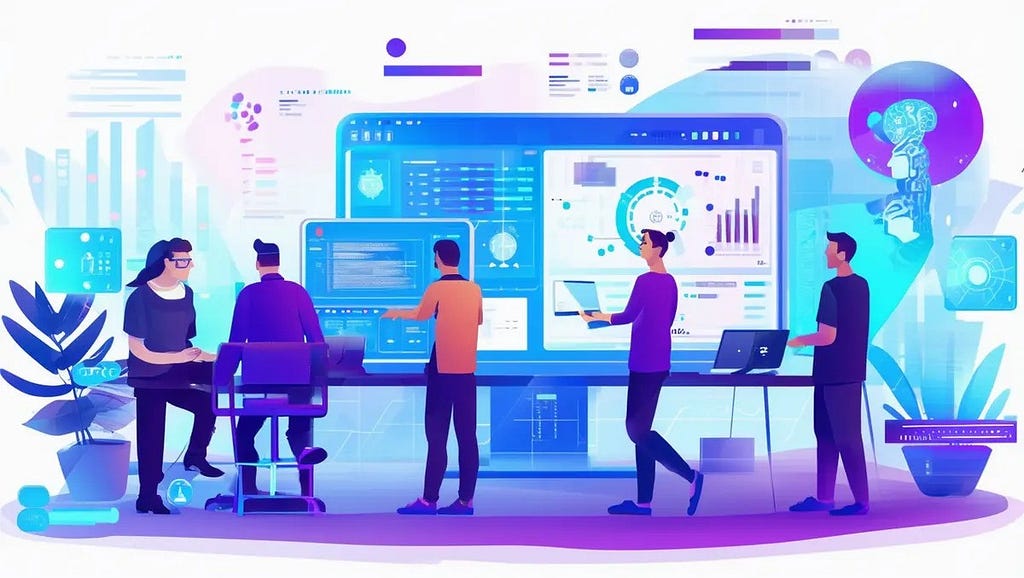
RAG app development is particularly useful in applications like chatbots, virtual assistants, and search engines, where the AI needs to process a wide variety of queries and provide the most relevant, fact-based responses. By leveraging retrieval techniques, RAG significantly reduces the risk of generating outdated or incorrect information, making it ideal for industries that rely on dynamic and extensive knowledge bases, such as healthcare, legal, and finance. As AI continues to evolve, RAG app development is becoming a cornerstone for building smarter, more reliable, and efficient AI-driven applications.
Table of ContentWhat is RAG App Development?Understanding RAG in Artificial Intelligence
How RAG Works in AI Development
The Role of RAG in Enhancing AI Efficiency
Benefits of RAG App Development in AI
How to Develop a RAG Application From Start to Finish?
RAG App Development: Real-World Applications
Challenges in Implementing RAG in AI Applications
Future of RAG in AI App Development
ConclusionWhat is RAG App Development?
RAG (Retrieval-Augmented Generation) app development is a cutting-edge approach that enhances artificial intelligence by integrating real-time data retrieval with language generation. In traditional AI models, responses are generated solely based on pre-existing training data, which can sometimes result in outdated or incomplete answers. However, with RAG, the model can access external sources such as databases, documents, or the internet to retrieve relevant, up-to-date information before generating a response.
This retrieval process helps the AI system provide more accurate, contextually aware, and precise answers by supplementing its internal knowledge with external data. RAG app development is particularly beneficial for applications like chatbots, virtual assistants, and search engines, where dynamic, fact-based responses are critical.
It improves the model’s performance by ensuring that the information used to generate responses is both current and relevant to the specific query. This approach is especially valuable in industries like healthcare, finance, and legal sectors, where real-time accuracy and expertise are crucial. RAG app development is transforming the way AI-powered applications can deliver smarter, more reliable results.
Join our Telegram to get more information about Crypto Trading.Understanding RAG in Artificial IntelligenceRAG (Retrieval-Augmented Generation) in artificial intelligence combines the power of data retrieval with language generation to improve AI’s accuracy and relevance. Traditional AI models rely solely on pre-trained knowledge, which may not always reflect the most current or specific information. With RAG, the AI system first retrieves relevant external data such as documents, databases, or the web before generating a response, ensuring that it draws from up-to-date and contextually appropriate information.
This integration enhances the AI’s ability to provide more precise, reliable answers across various applications, such as chatbots, virtual assistants, and search engines. RAG is particularly valuable in fields that require dynamic, fact-based responses, such as healthcare, finance, and legal services. By combining retrieval with generation, RAG allows AI models to be more accurate, flexible, and capable of adapting to rapidly changing information, making them smarter and more trustworthy.
How RAG Works in AI DevelopmentRAG (Retrieval-Augmented Generation) is a framework in AI development that combines retrieval-based methods with generative models to improve the quality and relevance of generated text. Here’s how it works:
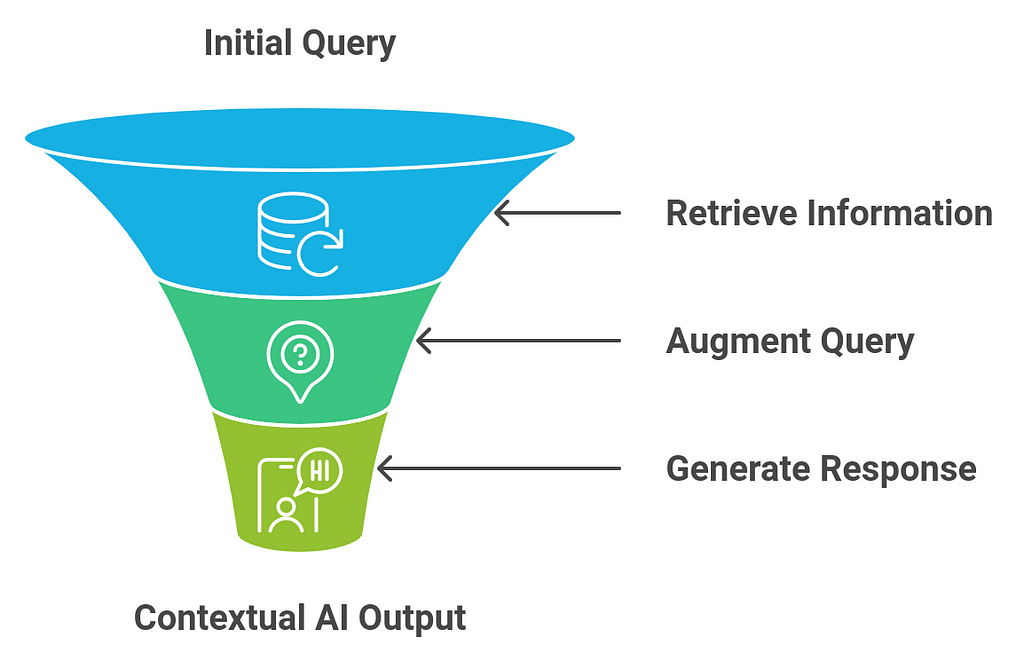 1. Retrieval Phase:
1. Retrieval Phase:- Search for Relevant Information: When a prompt or query is given, the system first retrieves relevant information from a database or external sources like documents, articles, or knowledge bases. This is typically done through an information retrieval (IR) system, which uses search algorithms to find the most relevant pieces of data based on the query.
- Contextual Relevance: The retrieved data helps provide context that the generative model can use to craft a more informed, accurate response.
- Enhancing the Query: The retrieved information is combined with the initial query or prompt to augment it. This gives the model additional context, making the response more specific and aligned with the available information.
- Preprocessing and Structuring: The retrieved content may be preprocessed in a format suitable for feeding into the generative model (e.g., converting documents to summaries or extracting key points).
- Text Generation: A language model (often a transformer-based architecture like GPT) then generates the final response, using both the augmented query and the retrieved content as input. The model integrates the retrieved data to provide a more informed, coherent, and contextually accurate response.
- Response Tailoring: The generative model tailors the output based on the additional context provided by the retrieval process, which helps the AI create responses that are more factually grounded and relevant.
RAG improves AI’s ability to produce high-quality, context-aware outputs by integrating real-time retrieval into the text generation process.
The Role of RAG in Enhancing AI EfficiencyRetrieval-augmented generation (RAG) plays a crucial role in enhancing the efficiency of AI systems by improving both the quality and speed of their responses, particularly in domains where up-to-date or specific information is necessary. Here’s a breakdown of how RAG contributes to AI efficiency:
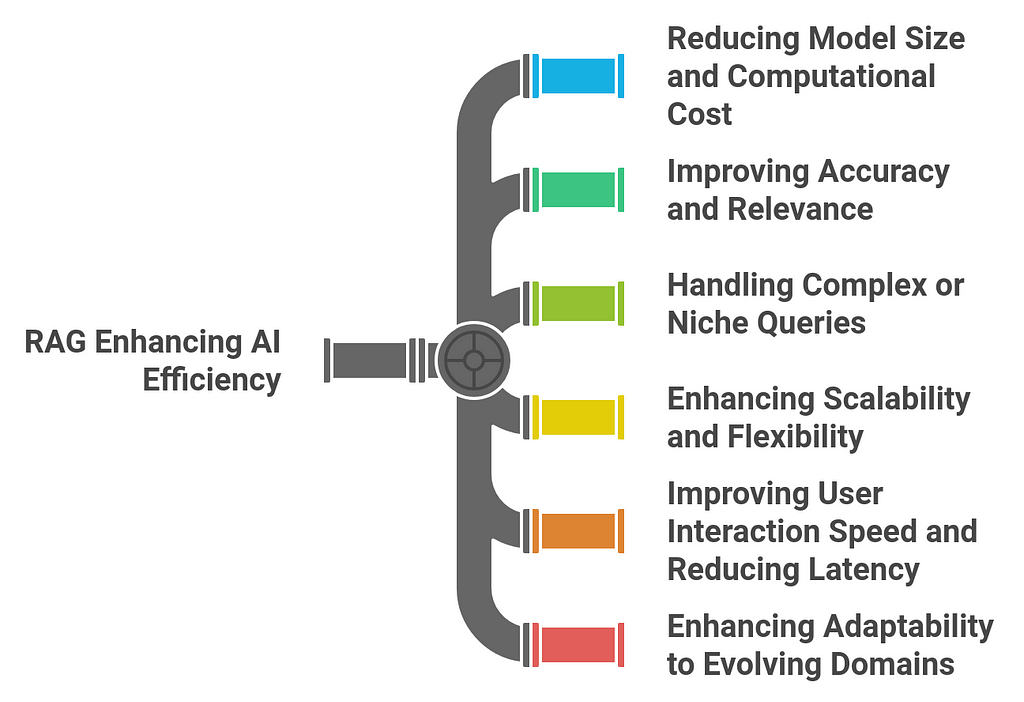 1. Reducing Model Size and Computational Cost:
1. Reducing Model Size and Computational Cost:- Knowledge Offloading: Instead of having to encode vast amounts of knowledge directly into a model’s parameters, RAG relies on external sources (e.g., databases, search engines, knowledge bases). This means the model doesn’t need to “remember” everything, reducing the need for immense storage capacity and computational resources.
- Faster Training: By offloading the retrieval step to an external system, RAG allows models to focus on generation tasks, which can lead to faster training times compared to fully end-to-end models that require the entire knowledge base to be encoded into the model.
- Access to Real-Time Data: One of the main benefits of RAG is that it allows AI models to pull in up-to-date, domain-specific, or contextually relevant information at the time of the query. This ensures the responses are more accurate and tailored to the user’s needs without requiring the model to have pre-encoded every fact or piece of data.
- Better Contextualization: The retrieval step ensures that the generative model works with relevant, precise, and often specialized information, leading to responses that are more grounded and relevant.
- Specialized Knowledge: RAG can retrieve highly specific knowledge from external sources that may be too vast or niche to be fully embedded in a pre-trained generative model. This is especially beneficial in specialized fields like healthcare, legal, or scientific research, where the model’s responses would need to be drawn from a specific and often changing body of knowledge.
- Dynamic Adaptability: Since RAG systems can dynamically retrieve information as needed, they adapt quickly to new knowledge or changing environments without needing to retrain the entire model or integrate this new knowledge directly.
- Scalable Data Integration: RAG allows for scalable systems that can continually update their knowledge base without requiring a complete retraining of the underlying model. When new data is available (such as new research papers, trends, or customer support documents), the retrieval system can access this information and augment the model’s output accordingly.
- Domain Generalization: The ability to pull from a wide range of sources enables RAG models to work across diverse domains. The same architecture can be used for answering customer service questions, generating reports, or providing medical advice, as long as the relevant data is available for retrieval.
- Quick Information Retrieval: Because the retrieval process is separate from the generative process, RAG systems can respond to user queries faster. The model doesn’t need to generate every piece of information from scratch; it simply pulls the relevant data and generates a response based on it.
- Faster Responses to Queries: RAG allows AI systems to handle more queries in less time, as the system can quickly access relevant information and generate responses efficiently, which can be particularly useful in high-demand applications like chatbots, customer support, or virtual assistants.
- Continuous Learning from Data: With retrieval systems in place, RAG can ensure that AI models stay updated with the latest information. This enables better handling of emerging trends, new research, or shifting contexts that would otherwise require re-training.
- Customizable Models: Organizations can adjust their retrieval systems to access specific knowledge, allowing the AI to adapt quickly to particular industries, use cases, or even evolving business strategies without the need for overhauling the entire system.
- Real-World Data Retrieval: By relying on external data sources, RAG models are less prone to overfitting the training dataset. The retrieval mechanism introduces variability into the generation process, making the model more flexible and robust in handling unseen queries and topics.
- Preventing Memorization: Since RAG integrates live retrieval, models are less likely to memorize facts from training data alone, instead relying on a more flexible combination of learned language patterns and external data.
RAG enhances AI efficiency by reducing computational overhead, improving the quality of generated content, increasing scalability, and ensuring that responses remain contextually relevant and up-to-date. It streamlines how AI systems manage large volumes of information, making them more effective and adaptable without the need for constant retraining. By retrieving the most relevant data, RAG systems can generate more accurate, timely, and efficient responses to a wide variety of queries.
Benefits of RAG App Development in AIRetrieval-augmented generation (RAG) in AI app development brings several significant benefits that improve both the performance and the usability of applications across various industries. Here’s how RAG enhances app development in AI:
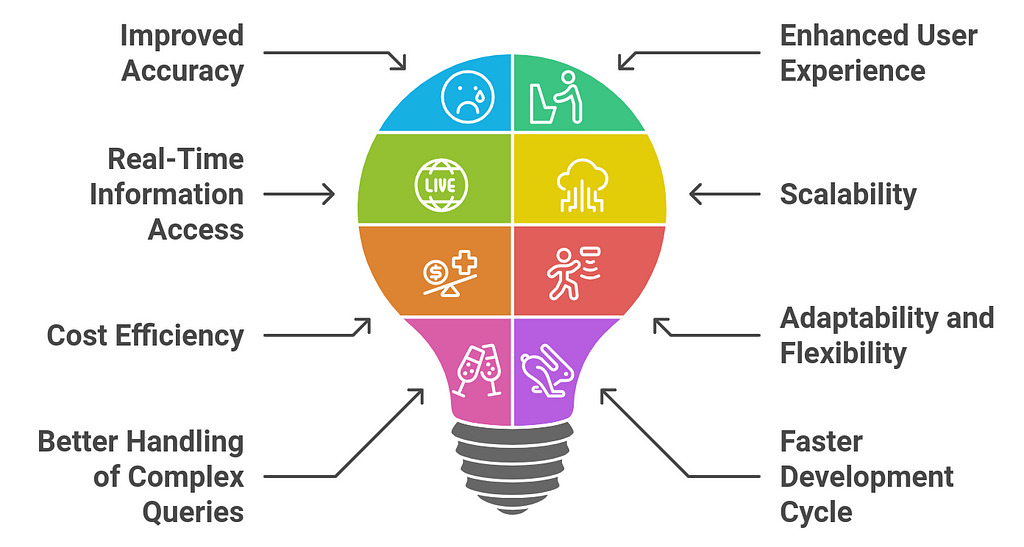 1. Improved Accuracy and Relevance:
1. Improved Accuracy and Relevance:- Contextual Responses: By leveraging external databases or real-time search, RAG allows AI apps to provide more accurate and relevant responses based on the latest information. For instance, in customer service apps, RAG can retrieve up-to-date FAQs, product specifications, or troubleshooting guides, ensuring that users receive the most relevant support.
- Reducing Knowledge Gaps: Apps can access a wider scope of knowledge without needing to encode everything within the model itself. This means AI apps can offer better coverage and avoid errors due to outdated or incomplete pre-trained data.
- Personalized Interactions: AI apps that use RAG can retrieve personalized or domain-specific data to deliver a more tailored experience. For example, a travel app can pull recent flight information or real-time weather updates to provide more personalized recommendations.
- Faster and More Efficient Responses: Since RAG enhances AI models by retrieving relevant information before generating a response, it allows for faster and more responsive applications. This is particularly valuable in mobile or real-time applications where quick interactions are critical.
- Dynamic Content Retrieval: RAG can retrieve live information from external sources, which is especially useful for apps in industries that are continuously evolving, such as news, healthcare, finance, and e-commerce. Apps can pull in the latest data (e.g., stock prices, news articles, medical updates) and generate insights or responses based on this fresh content.
- No Need for Constant Updates: Developers don’t need to constantly update the app’s knowledge base because the app can dynamically retrieve new data on demand, reducing maintenance costs and efforts.
- Efficient Handling of Large Data: For AI apps that need to handle large volumes of data (e.g., in knowledge management systems or enterprise tools), RAG allows developers to scale applications more easily. By retrieving relevant information as needed, developers don’t need to incorporate vast amounts of data directly into the app, which saves on storage and processing resources.
- Easy Expansion Across Domains: RAG-based apps can easily expand to different domains without needing to retrain the entire model for each specific area. For example, an AI-powered virtual assistant app can be adapted to different industries (like healthcare, finance, or retail) by simply changing the retrieval mechanism to pull relevant domain-specific data.
- Reduced Training Costs: Since RAG apps rely on external information retrieval, they do not require the costly and time-consuming process of training large-scale models with every possible piece of knowledge. Developers can use existing databases or even public APIs to enrich the app’s responses, which lowers the cost of development and maintenance.
- Lower Data Storage Requirements: RAG minimizes the need to store vast amounts of knowledge within the model itself. This reduces the storage cost and the computational burden typically required to manage and process massive datasets.
- Continuous Learning Without Re-training: Since the app pulls data dynamically, it can adapt to changing environments or knowledge without requiring frequent model retraining. For instance, an AI app in a fast-paced environment, like social media analytics or e-commerce, can remain current by simply pulling in the latest data or trends.
- Easy Customization: Developers can tailor the app’s retrieval system to access the specific types of data most relevant to their use case, allowing greater flexibility in-app functionality. A customer support AI can be programmed to retrieve troubleshooting articles, while a content generation tool can pull information from news or academic databases.
- Sophisticated Query Responses: RAG allows AI apps to handle complex, multi-faceted queries by retrieving a variety of relevant documents or data before generating a comprehensive response. This makes RAG-based AI apps much more effective at answering nuanced or complicated user questions.
- Reduction in Error Rates: With access to relevant, up-to-date, and varied information, RAG reduces the chances of the AI app generating incomplete or incorrect responses, improving the overall reliability of the app.
- Faster Prototyping: Since RAG systems can leverage pre-existing data and retrieve relevant information on demand, developers can create and prototype AI apps much faster. There’s no need to manually encode every knowledge item into the model or integrate a large number of specialized data sources.
- Simplified Maintenance: Updating the app with new data is easier because only the external sources need to be updated, not the entire model. This simplifies maintenance over time.
- Data Privacy: By using external retrieval mechanisms instead of storing large amounts of sensitive or private information, RAG-based apps can be designed with better privacy in mind. Sensitive data can remain external and not directly integrated into the app’s training data, reducing the risk of leakage.
- Access Control: Developers can implement access control for the retrieval layer, ensuring that only relevant or authorized data is fetched, further enhancing privacy and security.
- Healthcare Apps: RAG can pull in medical literature, research, and real-time patient data to offer more accurate diagnosis support, treatment recommendations, or patient insights.
- E-commerce Apps: RAG can retrieve product descriptions, reviews, and stock levels in real time, ensuring customers get up-to-date product information and personalized recommendations.
- Virtual Assistants: A RAG-powered virtual assistant app can use retrieval to answer complex user queries by fetching real-time information from the web, databases, or organizational knowledge bases.
RAG in AI app development brings immense value by improving accuracy, scalability, adaptability, and user experience. It enables apps to efficiently manage vast amounts of data, reduce training and storage costs, and provide dynamic, up-to-date responses. Whether in customer support, content creation, healthcare, or e-commerce, RAG enhances AI capabilities, making it an essential tool for building powerful, efficient, and responsive applications.
How to Develop a RAG Application From Start to Finish?Developing a Retrieval-Augmented Generation (RAG) application involves several steps, from planning the project to integrating retrieval and generation models, fine-tuning, and deploying the application. Below is a step-by-step guide on how to develop a RAG-based application from start to finish:
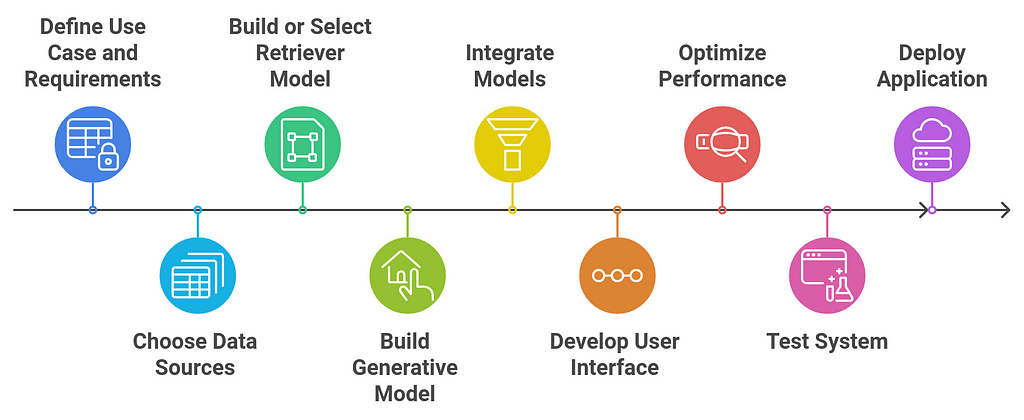 1. Define the Use Case and Requirements
1. Define the Use Case and Requirements- Identify the Problem: Determine the core problem your application will solve. This could be a question-answering system, a content generation tool, a chatbot, or any other application that benefits from both retrieving and generating information.
- Understand the Data Needs: Decide what data your application needs to retrieve. This could be from structured data (e.g., databases, APIs) or unstructured data (e.g., documents, web content).
- Define User Interactions: Specify how users will interact with your RAG app. Will they ask questions, submit requests, or perform other types of queries?
- Gather Data: Collect the data that your RAG system will retrieve from. This can be from:
- Knowledge Bases: Pre-existing documents, structured databases, or internal company knowledge bases.
- Web Data: Real-time data from the web, including news sites, blogs, forums, etc.
- External APIs: Use APIs to fetch data dynamically, such as weather data, stock market data, or specialized knowledge.
- Data Preprocessing: Clean and preprocess the data, especially if you’re dealing with unstructured data. This may include:
- Text Normalization: Removing irrelevant content, formatting text, stemming/lemmatization.
- Tokenization and Embedding: For textual data, you’ll need to create embeddings (e.g., using models like BERT, GPT, or any other pre-trained embeddings) for efficient search and retrieval.
- Retriever Models: The retriever is responsible for fetching relevant documents or data based on the user query. Depending on the type of data, you can use different retrieval approaches:
- Sparse Retrieval (Traditional): TF-IDF, BM25, etc. These methods rely on keyword-based matching and work well for structured data or smaller datasets.
- Dense Retrieval (Modern): Use models like DPR (Dense Passage Retrieval) or Colbert, which use neural embeddings to capture semantic relationships and retrieve relevant information more effectively.
- Search System: Set up a retrieval system that allows querying your data effectively. If you’re working with a large corpus, consider using specialized search engines like ElasticSearch, FAISS, or Pinecone to index and search the data.
- Choose a Generative Model: The generator is responsible for generating human-like text based on the retrieved data. Common models include:
- GPT-based Models: Such as GPT-3 or GPT-4 (via OpenAI’s API) or fine-tuned versions of GPT on your specific domain.
- T5, BART, or BERT Variants: These are transformer-based models that excel at text generation tasks. Fine-tuning them on your specific application can improve results.
- Fine-tuning the Model: Fine-tune the generative model on your specific task, such as generating answers, summaries, or personalized responses based on your use case. You can train the model using labeled data or use techniques like transfer learning to adapt a pre-trained model to your domain.
- Pipeline Setup: Integrate both the retriever and generator into a single pipeline. The typical flow is:
- User Query Input: The user submits a query or input.
- Information Retrieval: The retriever model searches for relevant data or documents from your knowledge base or external data sources.
- Contextual Generation: The generator model processes the retrieved data and generates a response, such as a natural language answer, a summary, or a piece of content.
- Re-ranking (Optional): If you retrieve multiple documents, use a ranking algorithm to prioritize the most relevant ones before passing them to the generator.
- Design the UI: Based on the type of app you are developing, create an interface that allows users to interact with the RAG system. This could be a chat interface, a search bar, or a custom form, depending on the use case.
- Conversational UI: For chatbots or question-answering systems, design a conversational flow.
- Search and Display: For applications like content generation, create a system where users can input queries and get structured outputs.
- Real-time Feedback: Implement a feedback mechanism to show users the results instantly or with minimal latency. Consider caching common queries to improve speed.
- Speed and Latency: RAG systems can involve multiple steps (retrieving and generating). Ensure that your application can process requests quickly by optimizing your retrieval and generation pipeline. Techniques like model distillation, quantization, and batch processing can help speed things up.
- Scalability: If you plan to scale the application, ensure that both the retrieval system (indexing large datasets) and the generative model can handle high user loads. You may need to use cloud platforms (e.g., AWS, Google Cloud, Azure) to scale your backend and storage or opt for edge computing for faster access.
- Caching and Indexing: Use caching techniques for frequently requested data and ensure the retrieval system is optimized for large datasets.
- Unit Testing: Test individual components, such as the retriever, generator, and user interface, to ensure they work as expected.
- Integration Testing: Perform integration testing to ensure that the retriever and generator work seamlessly together. This is crucial to identify any issues with how data flows between these components.
- User Testing: Conduct testing with actual users to understand how they interact with the system. Gather feedback on both the accuracy of the generated responses and the overall user experience.
- Feedback Loop: After deployment, continuously monitor the app’s performance. Collect user feedback and use it to further fine-tune the system. You can track the accuracy of generated responses, improve retrieval methods, or add more training data to the generative model.
- Model Updates: Depending on how dynamic your data is, update the retrieval system to ensure that it reflects any new information or knowledge that may have been added since the initial deployment.
- Cloud Deployment: Deploy the app on a cloud platform for easy scaling. You may need to deploy the retrieval system on specialized platforms (like ElasticSearch or FAISS for retrieval) and the generative model (like OpenAI’s API or custom-trained models) on cloud servers.
- API Integration: Expose the RAG model as an API if it needs to be integrated with other systems. For instance, the application can serve the AI responses via RESTful APIs that can be used by mobile apps, websites, or other services.
- Security Considerations: Implement proper security measures, especially if the app deals with sensitive data (e.g., encryption, secure API endpoints, privacy policies).
- Regular Updates: Ensure your application remains useful and up-to-date by regularly adding new knowledge sources, retraining the models if necessary, and incorporating new features based on user feedback.
- Monitor User Interactions: Track how users interact with the system, especially how they query it, and refine the user interface and experience based on usage patterns.
By following these steps, you can build and deploy a successful RAG-based AI application that efficiently retrieves and generates data in real-time, improving user experience and delivering highly relevant, context-aware outputs.
RAG App Development: Real-World ApplicationsRetrieval-augmented generation (RAG) is a powerful framework that has found applications across various industries, enhancing the capabilities of AI apps by allowing them to generate more accurate, relevant, and real-time responses. Below are some real-world applications of RAG in app development:
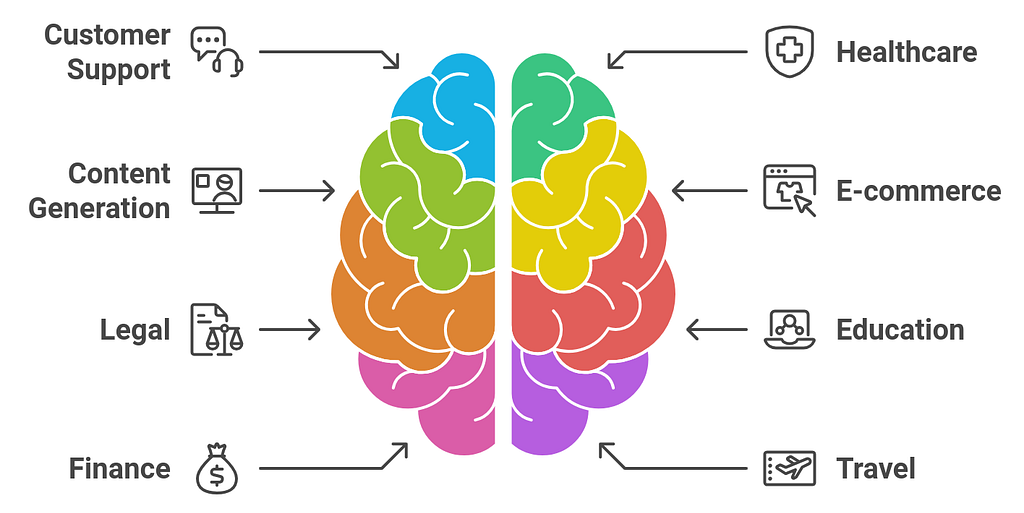 1. Customer Support and Chatbots
1. Customer Support and Chatbots- Application: Many businesses use AI-powered chatbots to answer customer queries. RAG allows these chatbots to retrieve up-to-date information from knowledge bases, FAQs, product documentation, or even support tickets to generate contextually accurate responses.
- Benefit: Customers receive more relevant and helpful responses based on the latest available information, reducing the need for human intervention. RAG-powered chatbots can quickly handle a wide variety of customer issues, from troubleshooting to billing inquiries.
- Example: A customer support chatbot for an e-commerce platform can retrieve the latest product stock details, order status, and return policies to provide users with accurate answers.
- Application: RAG can be used in healthcare apps to assist with clinical decision-making, patient education, or even in research applications. For example, AI tools in healthcare can retrieve the latest medical literature or clinical guidelines and generate personalized treatment suggestions or health information for patients.
- Benefit: RAG helps provide accurate, evidence-based, and up-to-date medical advice without the need for constant model retraining. This is particularly important in a field like healthcare, where new research and treatments are constantly emerging.
- Example: A medical assistant app could use RAG to retrieve the latest research articles on a particular disease or condition and generate tailored advice for healthcare providers or patients, keeping the information current.
- Application: AI tools that generate articles, reports, or even creative content can use RAG to retrieve the latest news, reports, or related information, which is then augmented and used to craft relevant and high-quality content.
- Benefit: RAG helps content generation apps stay relevant and factually accurate by incorporating real-time data into the writing process. This allows apps to create content that reflects the most current developments, trends, or facts.
- Example: A news app can use RAG to pull in the latest headlines and updates from trusted sources and then generate summaries or full articles based on this information, keeping content fresh and timely.
- Application: In the e-commerce sector, RAG can be used to retrieve real-time product information, stock levels, reviews, or even pricing changes from external databases or APIs. This information is then used to generate recommendations, dynamic pricing, and personalized shopping experiences.
- Benefit: RAG enables e-commerce apps to provide accurate product details, up-to-date availability, and real-time discounts without requiring frequent updates to the underlying AI models. Customers get personalized shopping experiences based on current data.
- Example: A personalized shopping assistant in an e-commerce app could use RAG to pull in up-to-date product information, such as pricing, availability, and user reviews, to generate recommendations based on a customer’s preferences.
- Application: Legal tech apps can use RAG to retrieve up-to-date legal documents, case law, or regulatory guidelines. This is particularly useful in apps that assist lawyers or businesses with compliance and legal research.
- Benefit: RAG-powered legal apps can access the most current legal precedents and regulations, making legal research faster and more accurate. This allows professionals to generate more informed legal documents, contracts, or compliance reports.
- Example: A legal research tool can use RAG to pull up relevant case laws or statutes based on a user’s query and generate summaries or detailed analyses to assist with legal advice or litigation strategies.
- Application: RAG can enhance e-learning apps by retrieving educational content, research papers, textbooks, or online articles to generate customized lessons, quizzes, or educational content based on a learner’s needs and progress.
- Benefit: RAG enables educational platforms to offer dynamic learning paths based on real-time information, ensuring that students are always exposed to the most current material.
- Example: A personalized learning assistant could use RAG to retrieve study materials or video lectures on a specific topic, generate quiz questions, and provide feedback on student progress based on real-time data.
- Application: RAG can be used in financial apps to retrieve up-to-date market data, investment trends, financial reports, and other relevant financial news. These apps can then generate personalized investment recommendations or financial insights for users based on current market conditions.
- Benefit: By integrating real-time data, RAG helps investors make more informed decisions, reflecting the most recent market shifts and news. This leads to better predictions, more accurate portfolio suggestions, and timely alerts.
- Example: An investment app can use RAG to pull the latest stock market news, retrieve historical performance data, and generate real-time investment strategies for users based on current trends.
- Application: RAG can improve travel apps by retrieving the latest flight availability, weather reports, tourist reviews, and hotel information. It can then generate personalized travel itineraries, trip recommendations, or even emergency travel assistance based on up-to-date data.
- Benefit: Users receive relevant, current travel information and suggestions, enhancing the user experience by providing them with real-time travel options and updates.
- Example: A travel app can use RAG to retrieve the latest flight deals, hotel availability, and local attractions, offering users real-time itinerary suggestions or last-minute travel deals based on their preferences.
- Application: Real estate apps can use RAG to retrieve up-to-date property listings, market trends, and local area information. These apps can generate personalized property recommendations, value estimates, or investment advice for users based on real-time data.
- Benefit: RAG allows real estate apps to offer more accurate property valuations and detailed area information without relying solely on static data. It also enables dynamic responses to market changes.
- Example: A real estate app can pull in current property listings, pricing trends, and neighborhood information to generate personalized suggestions and reports for users looking to buy or rent properties.
- Application: Social media apps can use RAG to retrieve and analyze real-time social media posts, news articles, or public sentiment data, then generate insights or trend analyses for businesses, marketers, or individuals.
- Benefit: RAG-powered sentiment analysis can provide accurate and up-to-date assessments of public opinion, allowing brands or social media managers to respond quickly to trending topics or customer feedback.
- Example: A sentiment analysis tool could retrieve recent tweets, articles, or social media posts about a brand or product and generate a report on public sentiment and emerging trends.
RAG-powered apps are revolutionizing multiple industries by enabling real-time, contextually relevant, and data-driven responses. Whether it’s customer service, healthcare, finance, e-commerce, or legal applications, RAG enhances the AI’s ability to pull in fresh, relevant data from external sources and generate precise, accurate responses. By integrating real-time information retrieval, businesses and developers can create smarter, more scalable applications that deliver value to users faster and more efficiently.
Challenges in Implementing RAG in AI ApplicationsImplementing RAG (Retrieval-Augmented Generation) in AI applications comes with several challenges that can impact its effectiveness. One key issue is ensuring the retrieval process is both efficient and accurate. The AI must quickly identify and extract relevant data from vast, often unstructured, sources like databases or the internet. This requires sophisticated indexing and search algorithms to filter out irrelevant information, which can be time-consuming and computationally expensive.
Additionally, there is the challenge of integrating the retrieved data with the generation process, ensuring the AI generates coherent and contextually accurate responses. Ensuring the AI doesn’t misinterpret or misuse retrieved information is another concern, especially when dealing with large and dynamic knowledge sources.
Managing the quality and reliability of external data sources is critical to avoid introducing errors or outdated information into the response. Furthermore, RAG applications must be scalable to handle a growing volume of data and queries, which can increase complexity and resource demands. These challenges must be addressed to fully harness the potential of RAG in AI.
Future of RAG in AI App DevelopmentThe future of Retrieval-Augmented Generation (RAG) in AI app development is incredibly promising. As AI technology continues to evolve, RAG is likely to play an increasingly important role in making AI applications smarter, more efficient, and capable of handling complex, real-world problems. Here are some key trends and predictions for the future of RAG in AI app development:
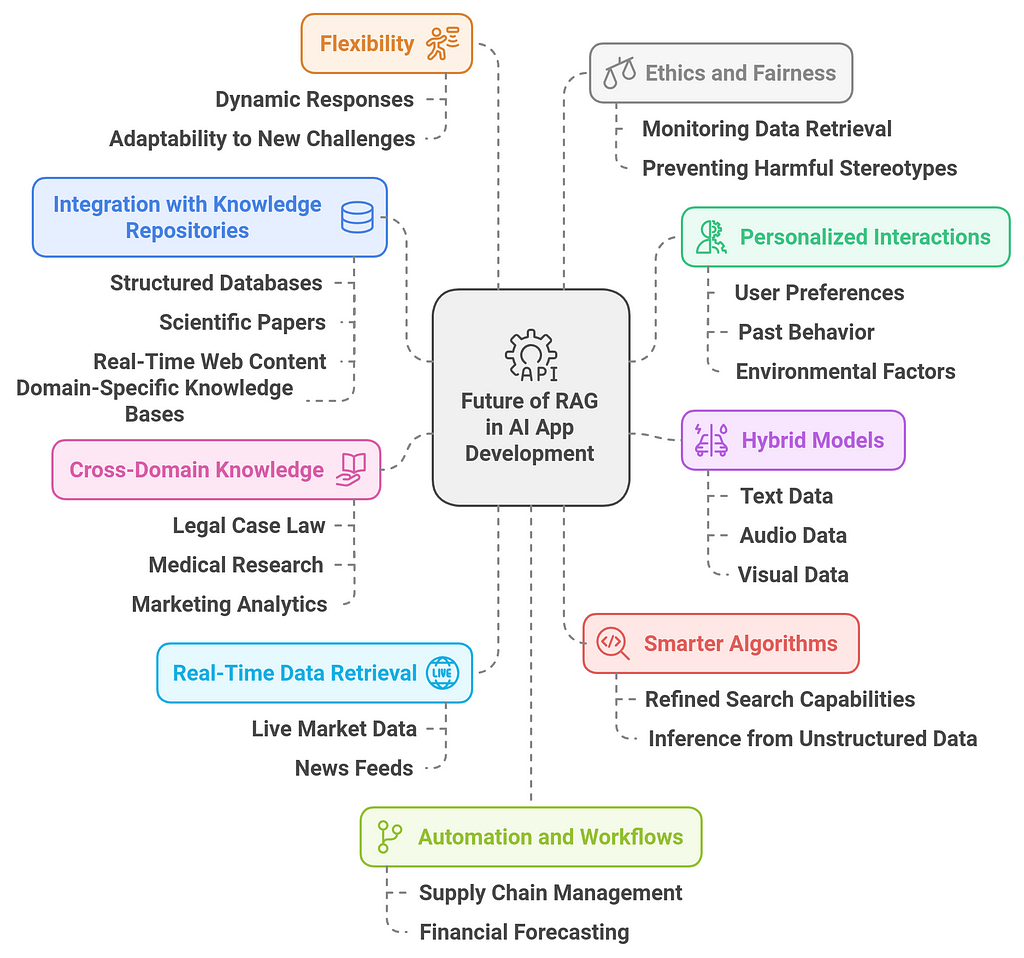 1. Integration with Large-Scale Knowledge Repositories
1. Integration with Large-Scale Knowledge Repositories- Expanding Access to External Data: As the amount of available data grows, RAG systems will increasingly be integrated with large-scale external knowledge repositories, including structured databases, scientific papers, real-time web content, and domain-specific knowledge bases. This will allow AI apps to access and synthesize diverse sources of information on demand.
- Example: AI-powered research tools could retrieve data from scientific journals, medical databases, and news sources in real time, providing researchers with more comprehensive insights and up-to-date information.
- Constantly Evolving Information: The future of RAG will see more dynamic and real-time data retrieval capabilities. As businesses and industries evolve rapidly, AI apps powered by RAG will be able to pull the most current data, ensuring that their responses and recommendations are timely and relevant.
- Example: In financial applications, RAG will allow for the integration of live market data and news feeds, enabling personalized and up-to-the-minute investment strategies.
- Context-Aware RAG Systems: Future RAG models will likely become more sophisticated in understanding and adapting to user context. This includes recognizing not just the immediate query but also the user’s preferences, past behavior, and environmental factors (e.g., location, time of day). This will enhance the AI’s ability to generate hyper-personalized responses and suggestions.
- Example: A virtual assistant using RAG could pull relevant data from a user’s calendar, past searches, and real-time news to generate a personalized daily brief or schedule.
- Combining Text, Audio, and Visual Data: As AI development moves towards multi-modal learning, future RAG systems will likely incorporate not only text-based information but also audio, video, and images. This will allow apps to retrieve and generate responses based on a combination of data types, enriching the AI’s ability to handle more complex and varied tasks.
- Example: A RAG-powered AI in a healthcare setting could retrieve medical imaging data alongside text-based clinical guidelines to generate diagnostic recommendations or assist with treatment planning.
- Advances in Search and Retrieval: The future of RAG will see improvements in the algorithms used to retrieve the most relevant data. Advanced AI models will refine search capabilities, enabling RAG systems to not only retrieve exact matches but also infer relationships and draw inferences from less structured data.
- Example: A legal research app could retrieve not only direct legal precedents but also related case law or analysis articles that provide additional context, helping legal professionals generate better-informed arguments.
- Data-Driven Learning: Traditional AI models often require significant hardcoding of rules or training on vast datasets to function effectively. With RAG, AI app development will shift toward more flexible, data-driven approaches. The ability to retrieve and generate on-demand knowledge will reduce the reliance on rigid model constraints and increase adaptability to new challenges or data.
- Example: Customer support systems will move beyond scripted responses to dynamically generated, contextually appropriate answers, making interactions feel more natural and responsive.
- Domain Agnostic RAG Models: Future RAG systems will be able to seamlessly operate across various domains. By retrieving data from multiple sources and domains, these systems will enable AI apps to transfer knowledge from one context to another, making them more versatile and efficient in handling cross-domain queries.
- Example: An AI app could help a lawyer, a doctor, and a marketer by retrieving relevant information from different domains (e.g., legal case law, medical research, and marketing analytics) and providing insights that apply across disciplines.
- Transparent and Fair Retrieval: As the use of RAG expands, there will be an increasing focus on ensuring that the retrieved data is free from biases, represents diverse perspectives, and aligns with ethical standards. Developers will need to implement robust mechanisms to monitor and audit the data retrieval process to prevent AI systems from propagating harmful stereotypes or misinformation.
- Example: A news aggregation app using RAG could be designed to retrieve content from a broad range of sources, ensuring that no single viewpoint dominates and that the content is balanced and unbiased.
- Automating Complex Tasks: As RAG becomes more efficient, it will increasingly be integrated into broader automation workflows, helping to automate more complex tasks that require both real-time data retrieval and intelligent generation. This could lead to more sophisticated systems for managing entire business operations, from supply chain management to financial forecasting.
- Example: In manufacturing, RAG could help an AI system automatically retrieve data on current inventory levels, supply chain disruptions, and demand forecasts to generate a real-time production plan.
- Human-in-the-Loop Systems: Even as RAG systems become more capable, there will still be areas where human oversight is necessary. In the future, RAG systems will likely work alongside human experts, providing them with data-driven insights, automating repetitive tasks, and offering suggestions that enhance human decision-making.
- Example: In healthcare, RAG systems could retrieve the latest research and treatment options, presenting them to doctors who can then combine the insights with their clinical expertise to make final treatment decisions.
- Distributed RAG Systems: Future RAG applications will likely integrate with cloud infrastructure and edge computing to provide faster and more efficient data retrieval, especially in environments where quick decisions are crucial. The combination of cloud and edge computing will allow for decentralized access to data and enable real-time generation of responses even in resource-constrained settings.
- Example: A mobile AI app used by field workers can retrieve and generate insights based on both cloud-based resources and locally stored data, providing high performance in remote locations without needing constant internet connectivity.
The future of RAG in AI app development will lead to more dynamic, personalized, and context-aware systems that can access vast and diverse sources of knowledge on demand. By improving data retrieval methods and integrating multiple types of data, RAG will make AI apps more scalable, flexible, efficient, and capable of adapting to rapidly changing environments. However, alongside these advancements, developers will need to prioritize issues such as ethics, transparency, and bias mitigation to ensure that RAG-powered AI systems are used responsibly. With these innovations, RAG will continue to play a pivotal role in transforming industries like healthcare, finance, education, and beyond.
ConclusionIn conclusion, RAG (Retrieval-Augmented Generation) app development represents a significant leap forward in AI technology by combining data retrieval with language generation to create smarter, more accurate applications. By enabling AI models to access real-time or specialized information, RAG enhances the model’s ability to generate contextually relevant and factually accurate responses. This development is particularly valuable in industries that demand high precision, such as healthcare, finance, and legal services, where the consequences of incorrect or outdated information can be substantial.
With RAG, AI applications become not only more reliable but also more efficient, reducing the risk of errors and improving overall user experience. As AI continues to integrate deeper into various sectors, RAG will play an increasingly important role in shaping the future of intelligent systems, ensuring they can handle a broader range of queries with the latest available data. Ultimately, RAG app development paves the way for more advanced, dynamic, and trustworthy AI-driven solutions that can adapt to the rapidly changing landscape of information.
FAQs1. What is RAG App Development?- Answer: RAG App Development refers to the process of creating applications that combine retrieval-based models with generation-based models to enhance the intelligence and responsiveness of AI systems. RAG models retrieve relevant information from external data sources (like databases or the web) and then use a generative model to create contextually relevant responses or insights.
- Answer: Traditional AI systems often rely solely on pre-trained models or static datasets for generating responses. RAG, on the other hand, enhances these systems by dynamically retrieving data from external sources, ensuring that the responses are always current and contextually appropriate.
- Answer: A RAG application typically consists of two main components:
- Retriever: A model that searches for and retrieves relevant information or data from a knowledge base or external data sources.
- Generator: A model (usually a language model like GPT or T5) that processes the retrieved data to generate coherent, contextually accurate responses or content.
- Answer: The retriever model searches through large datasets, such as documents or databases, to find the most relevant information based on a user’s query. It may use sparse methods (like TF-IDF or BM25) or dense methods (using embeddings from models like BERT or DPR) to match the query with relevant data.
- Answer: After the retriever model fetches the relevant data, the generator processes this information and generates a human-like response or content. The generator uses models like GPT, T5, or BART to craft coherent and contextually appropriate outputs based on the retrieved information.
Answer: RAG is used in a variety of AI applications, including:
- Chatbots and virtual assistants (for more intelligent and informed conversations).
- Customer service systems (to dynamically retrieve and generate accurate answers).
- Content generation tools (to pull in relevant data and create personalized content).
- Question-answering systems (where up-to-date answers are required).
Answer: The benefits include:
- Real-time, up-to-date information retrieval, and content generation.
- Improved accuracy and relevance in responses.
- Reduced need for retraining models as external data sources are used to generate dynamic responses.
- Better scalability, as new knowledge can be incorporated into the app without modifying the core model.
- Answer: Yes, RAG can handle multi-modal data, including text, images, and videos. As AI and retrieval models advance, systems are being developed to integrate image recognition models or video analysis with text-based generation models, creating a richer, more contextualized AI experience.
Answer: Challenges in developing RAG applications include:
- Data quality and ensuring that the retrieved information is relevant and accurate.
- Latency in retrieving and generating responses in real time, especially with large datasets.
- Integration complexity of different models for retrieval and generation.
- Biases in generated content from external data sources or models.
Answer: The future of RAG in AI includes:
- Better retrieval models with faster, more accurate responses.
- Seamless integration with diverse data sources and external APIs.
- Multi-modal AI capabilities, incorporating text, image, and video data.
- Smarter and more personalized experiences, as RAG models can be fine-tuned to individual preferences and real-time needs.
What Is RAG App Development and How Does It Apply to AI? was originally published in Coinmonks on Medium, where people are continuing the conversation by highlighting and responding to this story.
